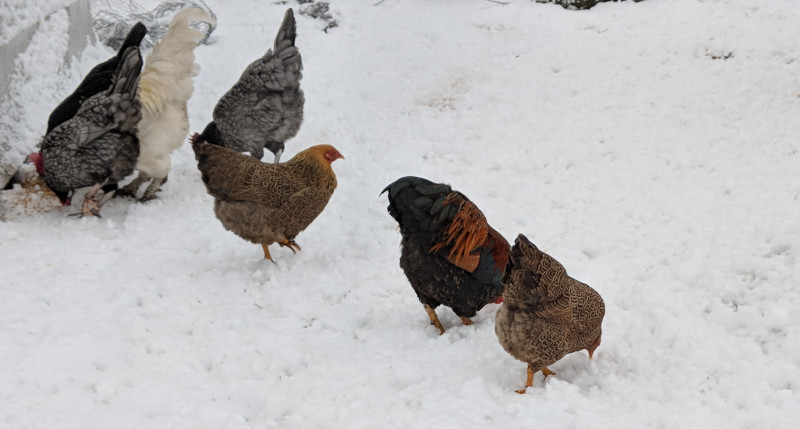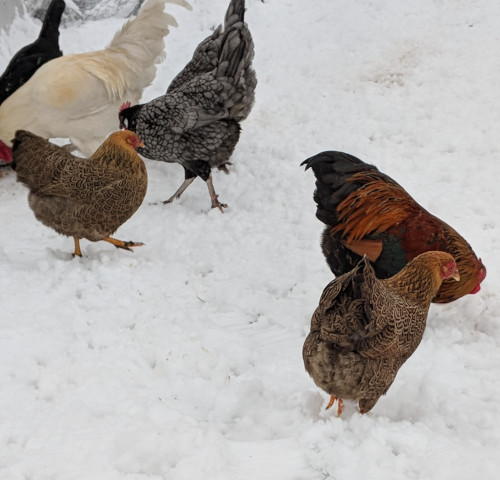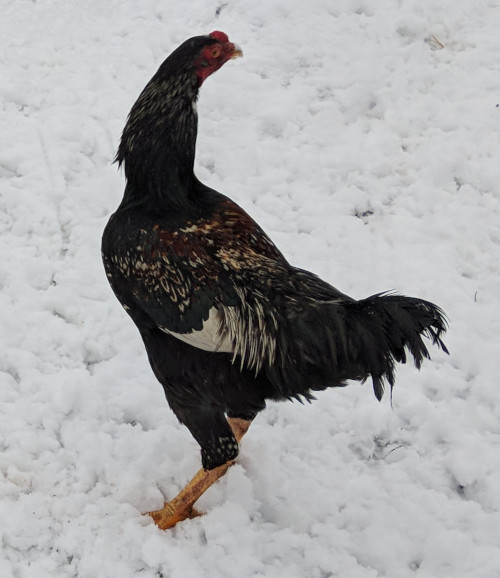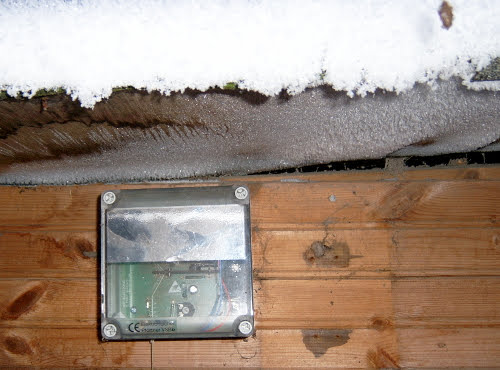What makes chickens cold hardy and which breeds are best?

Which are the best chickens for cold and snowy climates and what makes a cold hardy chicken.
Over the years I have kept many breeds in the north of England, an area well known for cold, windy, wet and snowy weather.
Table of Contents
- What makes a cold hardy chicken:
- Do chickens get cold feet?
- What happens to chickens when they get cold?
- What's the coldest chickens can tolerate?
- What breeds of chickens are cold tolerant?
- What chickens are not cold hardy?
- Tips For keeping chickens In cold climates:
- Which chickens lay eggs in the winter?
- Does a chicken coop need to be insulated?
- Does a coop need to be heated?
What makes a cold hardy chicken:
Cold hardy chickens have certain characteristics, they are normally heritage breeds from northern climates that are well covered in soft feathers and have smaller combs and wattles.
Cold hardy chickens tend to be:
- Heavy. Large heritage types do much better in the cold.
- Well feathered. Cold hardy chickens have a thick and even covering of feathers with plenty of down next to the skin.
- Small combs and wattles. Smaller combs stop heat being wasted and are less likely to get frost bitten.
- Shorter legs. Longer legs take more to keep warm and allow heat to escape from the body.
- Dual purpose heritage types. These older breed were produced for meat and eggs and are much hardier.
- Originally bred in northern climates.
- Fully feathered with no bare skin like Transylvanian Naked Necks.
- Clean legged. Counter intuitively clean legged chickens do better in cold and damp conditions. The leg feathers wet easily.
Bantams can be just as cold hardy as large fowl chickens.
Do chickens get cold feet?
Chickens do get cold feet but they are well adapted to cope with it. Chickens have a network of blood vessels in their legs that allows them to conserve heat in their body and not lose too much through their legs and feet.
Below: Chickens legs act as a heat exchange and a chickens feet can get quite cold and still work normally.

They often stand and raise one foot at a time into their feathers to warm it back up.
What happens to chickens when they get cold?
You can tell your chickens are getting cold when they:
- Huddle in the corners the coop and may smother each other in an effort to keep warm.
- Begin to lose colour in the comb and wattles and eventually suffer frostbite.
- Stand still in sheltered corners rather than indulging in natural behaviours.
- Go off their food and stop eating.
- Become very quiet and lethargic.
Below: Frostbite can happen to feet and toes as well as the comb and wattles.

What's the coldest chickens can tolerate?
So how cold is too cold for chickens? A few years ago we had sustained temperatures below -18 Celsius or -1 Fahrenheit for over six weeks and all my chickens were fine although I struggled daily keeping the water flowing.
Wind chill and damp feathers is more of an issue when it comes to cold chickens. A chicken that has a wet comb or wet and muddy feathers will get frostbite or chill at at a much higher temperature than a clean and dry bird.
You need to factor wind chill and local conditions into your calculations but below 0 Fahrenheit or -18 Celsius is too cold for chickens to be out for long.
Below that temperature the comb and toes will freeze rapidly and the chickens injured, disfigured or killed.
What breeds of chickens are cold tolerant?
Here is a list of breeds of chickens I have found to be the most cold tolerant based on my experience.
The breeds of chickens that do best in cold weather are those that were initially bred in cold climates like Northern Europe and the north of the US like:
- Barnevelder. Hails from the Netherlands and has small combs and wattles and thick soft feathering.
- Orpington. Large well feathers chickens with average combs and wattles do well in the cold.
- Marans. Another large soft feathered European chicken that is happy in the cold and damp.
- Jersey Giant. These very large well built chickens do nor feel the cold as much as some.
- Rhode Island Red. The RIR was developed to be able to cope with cold and wet winters.
- Sussex. All the members of the Sussex family of chickens are at home in cold and frozen conditions. they have finer combs and well covered bodies.
- Cochin. Another large and well feathered chicken with small combs that does well in the cold.
- Chantecler. This breed was created to survive the Canadian winters and still lay good numbers of eggs.
- Buckeye. A sturdy good foraging breed developed by Mrs. Nettie Metcalf and known to survive harsh conditions well.
- Australorps. Bred in Australia from the Orpington they have good feathering with plenty of down.
- Plymouth rocks. A hardy heritage breed with good body size, all members of the rock family of chickens do well in cold and icy climates.
- Welsummer. A brown egg layer from harsh northern European climates.
- Wyandotte. A large, compact and well feathered chicken that does well even in Canadian winters.
Which chicken breeds to get is a matter of personal choice.
What chickens are not cold hardy?
The Asian hard feather chickens like the Malay are not good for cold climates, the long lens and sparse feathers means they will get cold easily.
Other chickens that are not cold hardy are:
- Serama bantams - They are to small, as are most of the true bantams.
- Frizzles and frizzle feathered birds - The turned out feathers allows the cold to the skin.
- The Naked Neck Transylvanian and Show-girl Silkies have bare necks which will lose heat very quickly.
- Most meat birds or broilers have thin feathering making them susceptible to the cold.
- Tall and thin chickens. Asian hard feather like the Aseel and the Malay do not do well in the cold.
Below: This is a Shamo and he isn't happy in the cold.

He has a lot of surface area for his size, long legs and thin feathers with little down under-layer and he feels the cold a lot.
Tips For keeping chickens In cold climates:
- Keep your chickens well fed in cold weather. You will need to increase the calorie allowance for your flock as underfed chickens will get cold much more easily.
- Maintain a supply of liquid water all winter long.
- Ventilation to remove condensation from the coop is incredibly important as damp litter will make chickens cold and sick.
- Keeping your chickens and their coop dry. Dry chickens can tolerate very low temperature and wet ones will succumb to the cold very easily.
- Keep the chickens living quarters draft free. Your coop needs to be properly winterised with adequate ventilation.
- Consider using the deep litter method to help keep the coop warrm.
Which chickens lay eggs in the winter?
Modern hybrids are good winter layers and seem relatively unaffected by weather as long as they are kept well fed and watered. Heritage winter layers include Barnevelders, Welsummers, Australorps, Rhode Island Reds and Barred rocks.
Some chickens are well known as winter layers. I got Barnevelders when I first got chickens because they were good winter layers, mine gave me two eggs a week during the winter months after they had moulted.
Keeping chickens laying in winter requires good routine and feeding as well as some extra greens and high calorie feed.
Does a chicken coop need to be insulated?
Insulating a chicken coop brings a whole new set of problems. There is the cost and a Red mite infestation in an insulated chicken coop will be impossible to eradicate.
A coop need to be insulated if you live somewhere really cold but the dividing line is not easy to mark.
Below: You always need ventilation. See the ice crystals forming outside of the coop vents.

Does a coop need to be heated?
Some people put heat lamps or even heaters in their coops during the winter months or use heated water fountains for chickens to keep the water liquid.
A coop may need to be heated in some way if the temperature regularly drops below 0 Celsius or 32 Fahrenheit and the water freezes.
Chickens in a dry environment can easily withstand low temperatures down to 10 Fahrenheit or -12 Celsius but frozen water will be a huge problem.
